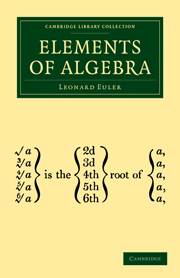Book contents
- Frontmatter
- ADVERTISEMENT
- MEMOIR OF THE LIFE AND CHARACTER OF EULER, BY THE LATE FRANCIS HORNER, ESQ., M. P.
- ADVERTISEMENT BY THE EDITORS OF THE ORIGINAL, IN GERMAN
- ADVERTISEMENT BY M. BERNOULLI, THE FRENCH TRANSLATOR
- Contents
- PART I Containing the Analysis of Determinate Quantities
- SECTION I Of the Different Methods of calculating Simple Quantities
- SECTION II Of the different Methods of calculating Compound Quantities
- SECTION III Of Ratios and Proportions
- Chap. I Of Arithmetical Ratio, or the Difference between two Numbers
- Chap. II Of Arithmetical Proportion
- Chap. III Of Arithmetical Progressions
- Chap. IV Of the Summation of Arithmetical Progressions
- Chap. V Of Figurate, or Polygonal Numbers
- Chap. VI Of Geometrial Ratio
- Chap. VII Of the greatest Common Divisor of two given Numbers
- Chap. VIII Of Geometrical Proportions
- Chap. IX Observations on the Rules of Proportion and their Utility
- Chap. X Of Compound Relations
- Chap. XI Of Geometrical Progressions
- Chap. XII Of Infinite Decimal Fractions
- Chap. XIII Of the Calculation of Interest
- SECTION IV Of Algebraic Equations, and of the Resolution of those Equations
- PART II Containing the Analysis of Indeterminate Quantities
- ADDITIONS BY M. DE LA GRANGE
Chap. III - Of Arithmetical Progressions
Published online by Cambridge University Press: 05 July 2011
- Frontmatter
- ADVERTISEMENT
- MEMOIR OF THE LIFE AND CHARACTER OF EULER, BY THE LATE FRANCIS HORNER, ESQ., M. P.
- ADVERTISEMENT BY THE EDITORS OF THE ORIGINAL, IN GERMAN
- ADVERTISEMENT BY M. BERNOULLI, THE FRENCH TRANSLATOR
- Contents
- PART I Containing the Analysis of Determinate Quantities
- SECTION I Of the Different Methods of calculating Simple Quantities
- SECTION II Of the different Methods of calculating Compound Quantities
- SECTION III Of Ratios and Proportions
- Chap. I Of Arithmetical Ratio, or the Difference between two Numbers
- Chap. II Of Arithmetical Proportion
- Chap. III Of Arithmetical Progressions
- Chap. IV Of the Summation of Arithmetical Progressions
- Chap. V Of Figurate, or Polygonal Numbers
- Chap. VI Of Geometrial Ratio
- Chap. VII Of the greatest Common Divisor of two given Numbers
- Chap. VIII Of Geometrical Proportions
- Chap. IX Observations on the Rules of Proportion and their Utility
- Chap. X Of Compound Relations
- Chap. XI Of Geometrical Progressions
- Chap. XII Of Infinite Decimal Fractions
- Chap. XIII Of the Calculation of Interest
- SECTION IV Of Algebraic Equations, and of the Resolution of those Equations
- PART II Containing the Analysis of Indeterminate Quantities
- ADDITIONS BY M. DE LA GRANGE
Summary
402. We have already remarked, that a series of numbers composed of any number of terms, which always increase, or decrease, by the same quantity, is called an arithmetical progression.
Thus, the natural numbers written in their order, as 1, 2, 3, 4, 5, 6, 7, 8, 9, 10, &c, form an arithmetical progression, because they constantly increase by unity; and the series 25, 22, 19, 16, 13, 10, 7, 4, 1, &c. is also such a progression, since the numbers constantly decrease by 3.
403. The number, or quantity, by which the terms of an arithmetical progression become greater or less, is called the difference; so that when the first term and the difference are given, we may continue the arithmetical progression to any length.
For example, let the first term be 2, and the difference 3, and we shall have the following increasing progression: 2, 5, 8, 11, 14, 17, 20, 23, 26, 29, &c., in which each term is found by adding the difference to the preceding one.
- Type
- Chapter
- Information
- Elements of Algebra , pp. 131 - 134Publisher: Cambridge University PressPrint publication year: 2009First published in: 1822

